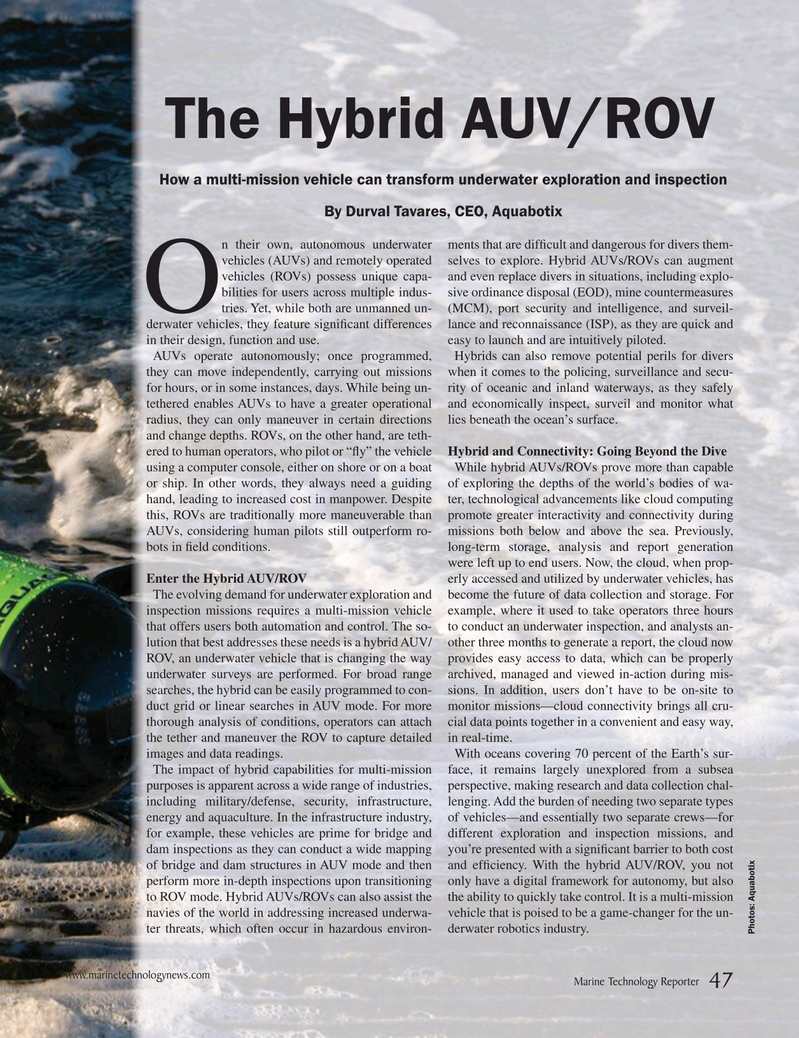
Page 47: of Marine Technology Magazine (October 2017)
AUV Operations
Read this page in Pdf, Flash or Html5 edition of October 2017 Marine Technology Magazine
The Hybrid AUV/ROV
How a multi-mission vehicle can transform underwater exploration and inspection
By Durval Tavares, CEO, Aquabotix n their own, autonomous underwater ments that are dif? cult and dangerous for divers them- vehicles (AUVs) and remotely operated selves to explore. Hybrid AUVs/ROVs can augment vehicles (ROVs) possess unique capa- and even replace divers in situations, including explo- bilities for users across multiple indus- sive ordinance disposal (EOD), mine countermeasures
Otries. Yet, while both are unmanned un- (MCM), port security and intelligence, and surveil- derwater vehicles, they feature signi? cant differences lance and reconnaissance (ISP), as they are quick and in their design, function and use. easy to launch and are intuitively piloted.
AUVs operate autonomously; once programmed, Hybrids can also remove potential perils for divers they can move independently, carrying out missions when it comes to the policing, surveillance and secu- for hours, or in some instances, days. While being un- rity of oceanic and inland waterways, as they safely tethered enables AUVs to have a greater operational and economically inspect, surveil and monitor what radius, they can only maneuver in certain directions lies beneath the ocean’s surface. and change depths. ROVs, on the other hand, are teth- ered to human operators, who pilot or “? y” the vehicle Hybrid and Connectivity: Going Beyond the Dive using a computer console, either on shore or on a boat While hybrid AUVs/ROVs prove more than capable or ship. In other words, they always need a guiding of exploring the depths of the world’s bodies of wa- hand, leading to increased cost in manpower. Despite ter, technological advancements like cloud computing this, ROVs are traditionally more maneuverable than promote greater interactivity and connectivity during
AUVs, considering human pilots still outperform ro- missions both below and above the sea. Previously, bots in ? eld conditions. long-term storage, analysis and report generation were left up to end users. Now, the cloud, when prop-
Enter the Hybrid AUV/ROV erly accessed and utilized by underwater vehicles, has
The evolving demand for underwater exploration and become the future of data collection and storage. For inspection missions requires a multi-mission vehicle example, where it used to take operators three hours that offers users both automation and control. The so- to conduct an underwater inspection, and analysts an- lution that best addresses these needs is a hybrid AUV/ other three months to generate a report, the cloud now
ROV, an underwater vehicle that is changing the way provides easy access to data, which can be properly underwater surveys are performed. For broad range archived, managed and viewed in-action during mis- searches, the hybrid can be easily programmed to con- sions. In addition, users don’t have to be on-site to duct grid or linear searches in AUV mode. For more monitor missions—cloud connectivity brings all cru- thorough analysis of conditions, operators can attach cial data points together in a convenient and easy way, the tether and maneuver the ROV to capture detailed in real-time. images and data readings. With oceans covering 70 percent of the Earth’s sur-
The impact of hybrid capabilities for multi-mission face, it remains largely unexplored from a subsea purposes is apparent across a wide range of industries, perspective, making research and data collection chal- including military/defense, security, infrastructure, lenging. Add the burden of needing two separate types energy and aquaculture. In the infrastructure industry, of vehicles—and essentially two separate crews—for for example, these vehicles are prime for bridge and different exploration and inspection missions, and dam inspections as they can conduct a wide mapping you’re presented with a signi? cant barrier to both cost of bridge and dam structures in AUV mode and then and ef? ciency. With the hybrid AUV/ROV, you not perform more in-depth inspections upon transitioning only have a digital framework for autonomy, but also to ROV mode. Hybrid AUVs/ROVs can also assist the the ability to quickly take control. It is a multi-mission navies of the world in addressing increased underwa- vehicle that is poised to be a game-changer for the un- ter threats, which often occur in hazardous environ- derwater robotics industry.
Photos: Aquabotix www.marinetechnologynews.com
Marine Technology Reporter 47
MTR #8 (34-49).indd 47 MTR #8 (34-49).indd 47 9/28/2017 3:01:13 PM9/28/2017 3:01:13 PM

 46
46

 48
48
